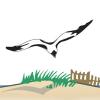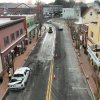I think we all agree we want to preserve our beaches.
Nature gives us help with this by blowing and washing debris ashore from the marshes around the bay. This beach wrack is washed up to the storm high tide lines. If left alone, wind and waves bury the matted stems under the sand. This not only builds up the beach, but also stabilizes the sand, and provides a natural habitat in which plants and both micro and macro organisms can thrive.
Alas, this natural process is thwarted by our continued use of a tractor style beach rake. This machine has raked up almost all the wonderful winter debris, much of which was already two-thirds buried and well out of the way of beach users.
I believe there are uses for the rake. Sometimes after storms, large pieces of wood, perhaps with nails, needs to be removed. I am also grateful for the removal of dead, smelly horseshoe crabs at the end of their egg laying season, although they too provide food for other beach denizens.
Most of the rest of the summer, there is no reason to rake the beach. A natural crust forms in the sand that helps resist erosion by wind and water. The rake breaks up this crust and makes it easier for the sand to wash and blow away.
I have been walking Lewes Beach for 40 years and have never seen any biohazards such as syringes. The occasional trash washed up by the waves is usually picked up by beach walkers and disposed of in the blue trash cans provided by the city. If a lot of trash is left on the Public Beach, that area could be raked. The other 90 percent of the beach should be left alone to heal and rebuild itself the way nature intended.
Lucinda Murphy
Lewes



















































